American Whiskey: From Moonshine to Modern Day Revival
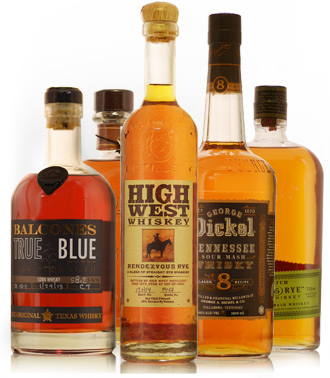
While the first settlers from England were used to drinking beer and Gin, Bourbon and its sister American whiskies have their origins in the arrival of a second wave of immigrants in the young colonies. In the early 1700's a combination of bad economic times and religious unrest against the Established Church in Great Britain set off a wave of emigration from Scotland and Ireland. These settlers who came to be known as the "Scotch-Irish" in the new World, brought to North America their religion, their distrust of government control, and their skill at distilling whiskey.
They settled in Pennsylvania, Maryland and Virginia, and began producing whiskey from whatever grain was available. Mostly small farmers, they quickly adapted to growing rye because of its hardiness, and, in the western counties, Native American corn because of its high yields. As in the Scottish past, it was a useful way of using surplus produce, and provided the distiller with a commodity he could trade, using it as a form of currency. In Pennsylvania these were primarily Rye whiskies; farther to the west and south Corn whiskies predominated. By the end of the American War of Independence in 1784, the first commercial distilleries had been established in what was then the western Virginia county of Kentucky.
The watershed came in 1791 when the new president, George Washington, imposed the first tax on whiskey to raise desperately needed revenue for his administration. (Ironically, Washington himself was a noted distiller in his home state of Virginia). True to form, the Scots and Irish distillers, amongst the country's most loyal citizens, revolted. Federal tax agents were assaulted and killed by angry mobs. Washington was forced to send in an army of 15,000 militiamen (led by himself) to quell the Whiskey Rebellion and collect the tax. The ringleaders were convicted and sentenced to be hanged, but cooler heads prevailed, and after jail time they were pardoned and released. Many distillers still refused to pay, and pushed westwards into what was to become Kentucky, Tennessee and further west, carving new farms out of the wilderness where
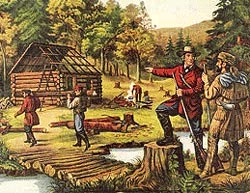 |
| Above: Pioneer distiller James Crow Building his First Distillery In a Log Cabin on Glenn's Creek near Frankfort Kentucky. Crow carried out experiments that revolutionized whiskey making in America. |
Washington and his tax men could not reach them. They followed the limestone belt that starts in Pennsylvania and ends at Baltimore in Maryland. It assured them of the pure water they needed to distill. These first whiskies were made from whatever was to hand, and sported such names as 'Old Bustard'. However as the country was cleared and the markets became more sophisticated, distinctions began to be made among them. At first it was rye or corn, Kentucky or Tennessee. But Bourbon County in Kentucky was particularly noted for its whiskies, and gave its name eventually to a distinctive style of whiskey, as Chuck Cowdery explains:
"When American pioneers pushed west of the Allegheny Mountains following the Revolution, the first counties they founded covered vast regions. One of these original, huge counties was Bourbon, established in 1785 and named after the French royal family. While this vast county was being carved into many smaller ones, early in the 19th century, many people continued to call the region Old Bourbon. Located within Old Bourbon was the principal Ohio River port from which whiskey and other products were shipped to market. "Old Bourbon" was stenciled on the barrels to indicate their port of origin. Old Bourbon whiskey was different because it was the first corn whiskey most people had ever tasted, and they liked it. In time, bourbon became the name for any corn-based whiskey."[1]
By the 1840's Bourbon was being recognized and marketed as a distinctively American product, although not as a regionally specific spirit. Bourbon came to be produced in Kentucky, Tennessee, Indiana, Illinois, Ohio, Missouri, Pennsylvania, North Carolina, and Georgia, among other states. Initially Bourbon was made in pot stills, but as the century progressed the new column still technology was increasingly adopted. The last old-line pot still plant closed in Pennsylvania in 1992, but the technique was revived in Kentucky in 1995 when the historic Labrot & Graham Distillery was renovated and reopened with a set of new, Scottish-built copper pot stills.
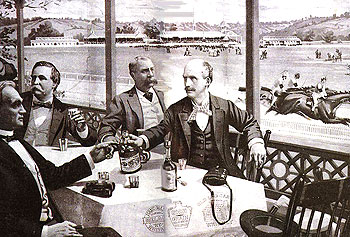 |
| Gentlemen enjoying a whiskey at the Kentucky Derby, today one of America's most famous horse races. During the event, more than 80,000 Mint Juleps are served at Churchill Downs. See below for the recipe. |
The late 19th century saw the rise of the Temperance Movement, a social phenomenon driven by a potent combination of religious and women's groups. Temperance societies, such as the Women's Christian Temperance Union and the Anti-Saloon League, operated nationally, but were particularly active in the southern states. The notion of temperance soon gave way to a stated desire for outright prohibition, and throughout the rest of the century an assortment of states and counties adopted prohibition for varying lengths of time and degrees of severity. This muddle of legal restrictions played havoc in the Bourbon industry, as it interfered with the production and aging of stocks of whiskey.
National Prohibition in 1919 had effects on the Bourbon industry beyond shutting down most of the distilleries. Drinking did not stop, of course, and the United States was soon awash in illegal alcohol, much of it of dubious quality. What did change was the American taste in whiskey. Illicit moonshine and imported Canadian whiskeys were lighter in taste and body than Bourbon and Rye. The corresponding increase in popularity of white spirits such as Gin and Vodka further altered the marketplace. When Repeal came in 1933, a number of the old distilleries didn't reopen, and the industry began a slow consolidation that lasted into the early 1990's, at which time there were only ten distilleries in Kentucky and two in Tennessee. Out of Bardstown in the low, rolling hills are the springs that provide the water for distillation. The distillers settled in the valleys by them and built an industry. Today water can be piped, and some of the bigger distilleries partly use normal town supplies. The older distilleries have a prosaic charm about them, like Maker's Mark, but the modern ones, ringed by the maturation warehouses, are squat, ugly but functional.
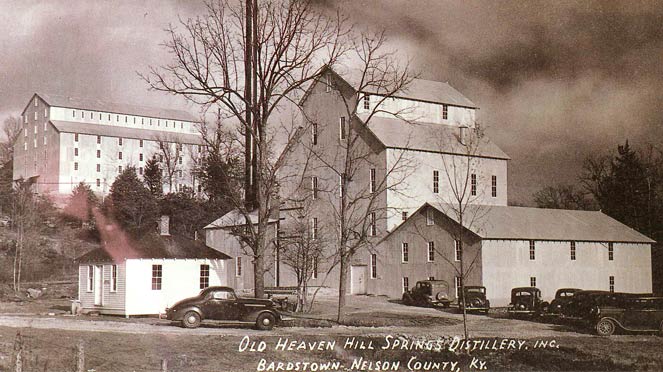
The old Heaven Hill Distillery, Bardstown, Kentucky. Like most distilleries, function precedes form.
As has been mentioned, apart from Bourbon, there are other types of North American whiskey - Tennessee and Rye whiskies for example, which we will discuss in detail below. These whiskies tend to be the preserve of Pennsylvania, Maryland and Virginia. If George Washington had not decided to slap a tax on those early distillers, one of these spirits may well have become the classic American whiskey. But he did, and Bourbon, first made by those stubborn Scots and Irish settlers, took their place.
American Whiskey Heartland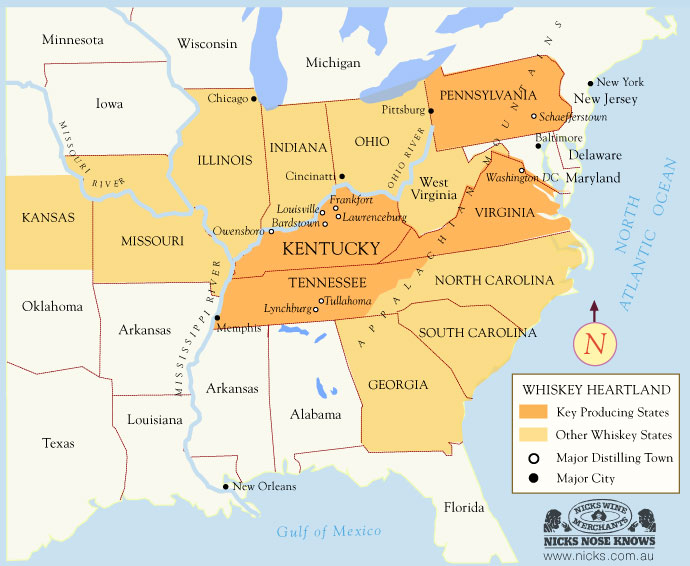
Above: The Key Whiskey Producing States on the East Coast of America. While the early whiskey producing states of significance were Pennsylvania, Maryland & Virginia, today it is Kentucky and Tennessee which are foremost in Bourbon lover's minds. Nevertheless, other states produce a range of contrasting styles making Whiskey Heartland a journey of discovery and excitement.
Producing Bourbon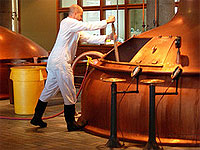 Good bourbon is generally made from a grain mash that is about two parts or slightly more corn, and one part equally of rye and barley, or possibly a little wheat. Each distiller takes great care in selecting the grains, making choices based on quality, ripeness and moisture content. These grains are ground into a meal and mixed in intervals with the iron-free limestone water. The mixture is then "mashed" or cooked. During this process the mash produces starch, which upon further cooking become maltose, or grain sugar. A strain of yeast added to the mixture converts the sugar to alcohol, beginning fermentation. The strains of yeast used in fermenting mash in the various Bourbon distilleries make one brand of Bourbon different from another and are closely guarded secrets in the industry. The yeast is believed to affect the body, aroma and taste of the Bourbon as much as the aging process. Many strains have been passed from generation to generation in family-owned distilleries and are still used today. Fermentation takes place in large tubs, some with a capacity of up to 50,000 gallons. In the early days of Bourbon making, tubs made of cypress wood were used to hold the mash. Although some distilleries still use cypress, stainless steel tubs are now common. After three to four days of fermenting, the mash is then transferred into another container for distilling. The resulting crystal clear liquid is distilled or separated from the mash. At this point, the mixture is eight to nine percent alcohol, making it 16 to 18 proof. Continuous stills and copper pot stills are used to heat the mash and gather the vapor. The vapor cools as it travels through the still and is reconverted into a liquid, known in distilling circles as "low wine" or "distiller's beer," containing from 45 to 65% Alc./Vol. (or 90 to 130 proof). Most distillers use a doubler still, resembling a large pot, to further refine the low wine into high wine, a clear liquid, ready for aging. High wine contains from 50 to 57.5% Alc./Vol. (100 to 115 proof), depending on the final product desired. However, the higher the proof of a Bourbon, the lower the amount of flavoring elements it contains.
Good bourbon is generally made from a grain mash that is about two parts or slightly more corn, and one part equally of rye and barley, or possibly a little wheat. Each distiller takes great care in selecting the grains, making choices based on quality, ripeness and moisture content. These grains are ground into a meal and mixed in intervals with the iron-free limestone water. The mixture is then "mashed" or cooked. During this process the mash produces starch, which upon further cooking become maltose, or grain sugar. A strain of yeast added to the mixture converts the sugar to alcohol, beginning fermentation. The strains of yeast used in fermenting mash in the various Bourbon distilleries make one brand of Bourbon different from another and are closely guarded secrets in the industry. The yeast is believed to affect the body, aroma and taste of the Bourbon as much as the aging process. Many strains have been passed from generation to generation in family-owned distilleries and are still used today. Fermentation takes place in large tubs, some with a capacity of up to 50,000 gallons. In the early days of Bourbon making, tubs made of cypress wood were used to hold the mash. Although some distilleries still use cypress, stainless steel tubs are now common. After three to four days of fermenting, the mash is then transferred into another container for distilling. The resulting crystal clear liquid is distilled or separated from the mash. At this point, the mixture is eight to nine percent alcohol, making it 16 to 18 proof. Continuous stills and copper pot stills are used to heat the mash and gather the vapor. The vapor cools as it travels through the still and is reconverted into a liquid, known in distilling circles as "low wine" or "distiller's beer," containing from 45 to 65% Alc./Vol. (or 90 to 130 proof). Most distillers use a doubler still, resembling a large pot, to further refine the low wine into high wine, a clear liquid, ready for aging. High wine contains from 50 to 57.5% Alc./Vol. (100 to 115 proof), depending on the final product desired. However, the higher the proof of a Bourbon, the lower the amount of flavoring elements it contains.
 |
But the real secret of the flavour of Bourbon is its maturation in charred American oak barrels. Bourbon is aged innewwhite oak barrels, unlike the used barrels of other whiskey types. This new wood means that the Bourbon draws a great deal of colour and flavour from the barrel, with vanilla and caramel predominant characteristics. No one knows how or why the charring of the insides of barrels began, but logically it was probably used as a way of cleaning the cask, much the same way as sulphur is used in wineries today, and someone found it imparted a special taste to the new spirit. Indeed, the colour, the caramel, smoke, vanilla and even the dry tannic nip in older bourbons, are all characteristics imparted to Bourbon courtesy of charred oak.
For the storage and maturation of the whiskey in barrel, each distillery has its own preferences. In the past huge warehouses with a height of four to five floors were established, usually with a capacity for around 20,000 barrels. Such warehouses have a skeleton of bars and joints to be able to roll the barrels horizontally. In between this skeleton there are elevators, which permit the vertical movement of the barrels. Where barrels are stored in a warehouse, the immediate environment can make a considerable impact upon how the whiskey matures. In the Kentucky summer, very high temperatures occur near the roof, while the bottom remains as cool as in an air-conditioned area. This means that with the rapid expansion and contraction of the spirit into and out of the wood, maturing happens at a quicker rate than for example in the cool, damp climates of Scotland or Ireland.In order to adjust the temperature, warehouses have many windows which can be opened when required.Temperature changes also cause pure water in the whiskey to evaporate, so the barrels when opened commonly contain much less liquid than when they were filled. Bourbon loses about three percent of its volume for each year of aging, but contain between 10 and 20 percent more alcohol.
Because the whiskey matures differently on different floors, the barrels were traditionally rotated to maximise consistency. (Maker's Mark are one of the few distilleries that still rotate their barrels).  Today, instead of rotating, most distilleries mix the barrels from different positions of the warehouse before bottling. With this labor saving procedure they reclaim a region of the warehouse in which outstanding barrels for Small Batch Bourbons and Single Barrel fillings are often found (usually this is the very center of the warehouse, called 'the heart' of the warehouse.) The principle behind 'Small Batch' concept is that each barrel of Bourbon varies, and the whiskey in it acquires a slightly different flavour profile. The master distiller periodically samples the whiskey in barrels, especially those barrels in the best part of the warehouse. Those barrels that are discovered to contain unusually fine whiskey are recorded and tracked with care. There is no margin for error because there is no way to compensate for flavour by mixing the spirit with any other liquid at a later period. At considerable expense to the distillery, the selected barrels are allowed to mature in years far beyond the average age of Bourbon. When they are at their peak of perfection, they are taken from the warehouse and bottled one barrel at a time and then packaged by hand. In this way the cream of the crop, so to speak, becomes single barrel Bourbon. The intended result is a new classic every time: unfiltered, uncut - Bourbon of a most individual expression. As a consequence, each bottling can vary in style and flavour.
Today, instead of rotating, most distilleries mix the barrels from different positions of the warehouse before bottling. With this labor saving procedure they reclaim a region of the warehouse in which outstanding barrels for Small Batch Bourbons and Single Barrel fillings are often found (usually this is the very center of the warehouse, called 'the heart' of the warehouse.) The principle behind 'Small Batch' concept is that each barrel of Bourbon varies, and the whiskey in it acquires a slightly different flavour profile. The master distiller periodically samples the whiskey in barrels, especially those barrels in the best part of the warehouse. Those barrels that are discovered to contain unusually fine whiskey are recorded and tracked with care. There is no margin for error because there is no way to compensate for flavour by mixing the spirit with any other liquid at a later period. At considerable expense to the distillery, the selected barrels are allowed to mature in years far beyond the average age of Bourbon. When they are at their peak of perfection, they are taken from the warehouse and bottled one barrel at a time and then packaged by hand. In this way the cream of the crop, so to speak, becomes single barrel Bourbon. The intended result is a new classic every time: unfiltered, uncut - Bourbon of a most individual expression. As a consequence, each bottling can vary in style and flavour.
After the barrels have been used once to mature Bourbon, they are shipped overseas where they are reused over and over again to make European style whiskies. If you like Scotch or Irish whisky one has to give thanks to Kentucky Bourbon and the Kentucky crafted American white oak barrels.
Labeling Terminology of American Whiskies
North American whiskies are essentially classified by the type or variety of grains in the mash bill, the percentage or proof of alcohol at which they are distilled, and the length and manner of their aging.
Bonded Whiskey, such as Jim Beam's Bonded, is 100 proof Bourbon from a single distillery that was produced in a single "season" and then aged for at least four years in a government-supervised "bonded" warehouse. Distillers originally did this in order to avoid having to pay the excise tax until the whiskey was aged and ready for market. Consumers came to (incorrectly) regard the "bottled in bond" designation as a statement of quality. Bonded whiskies are not much of a factor in today's market, although they still exist. The Mash is the mix of crushed grain (including some malt that contains enzymes to break down grain starches into sugars) and hot water from which the distiller draws a liquid extract called wort. The wort is fermented into a simple beer called the wash, which is then distilled.
Sour Mash is a refinement usually credited to Dr. James C. Crow. Using the sour mash process, each new fermentation is conditioned with some amount of spent mash (previously fermented mash that has been separated from its alcohol). The acid introduced by using the sour mash controls the growth of bacteria that could taint the whiskey and creates a proper pH balance for the yeast to work. As of 2005, all straight bourbons use a sour mash process. Dr. Crow developed this refinement while working at the Old Oscar Pepper Distillery (now the Woodford Reserve Distillery) in Woodford County, Kentucky. (Spent mash is also known as distillers spent grain, stillage, slop or feed mash, so named because it is used as animal feed.)
Straight Whiskey is unblended whiskey that contains no neutral spirit. Bourbon, Tennessee, Rye, and Corn whiskey are straight whiskies. There is also a spirit, simply called "straight whiskey," that is made from a mixture of grains, none of which accounts for 51% of the mash bill.
Small Batch Bourbons are bottled from a small group of specially selected barrels that are blended together.(It should be noted though that each distiller has their own interpretation of what constitutes a "small batch." )
Single Barrel Bourbonis Bourbon from one specifically chosen cask.
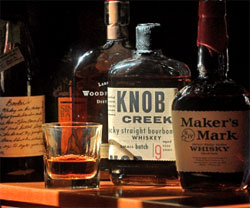 The Types of North American Whiskey
The Types of North American Whiskey
The 38th Congress of the United States finally got round to codifying the various types of whiskey in 1964, and though bourbon is no longer made anywhere in Bourbon County, the industry has settled around Louisville and Bardstown, where Stephen Foster had his old Kentucky home, still standing today. North American whiskies are all-grain spirits that have been produced from a mash bill that usually mixes together corn, rye, wheat, barley and other grains in different proportions, and then generally aged for an extended period of time in wooden barrels. These barrels may be new or used, and charred or uncharred on the inside, depending on the type of whiskey being made. Most North American whiskies are made in column stills.
The United States government requires that all whiskies:
- Be made from a grain mash.
- Be distilled at 90% ABV or less.
- Be reduced to no more than 62.5% Alc./Vol. (125 proof) before being aged in oak barrels (except for Corn whiskey, which does not have to be aged in wood).
- Have the aroma, taste, and characteristics that are generally attributed to whiskey.
- Be bottled at no less that 40% ABV (80 proof). It's also worthwhile noting that no caramel colouring is permitted in American whiskies.
Rye Whiskey
The Scotch-Irish immigrant distillers had some exposure to using rye in whiskey production, but for their German immigrant neighbors rye had been the primary grain used in the production of Schnapps and Vodka back in northern Europe. They continued this distilling practice, particularly in Pennsylvania and Maryland, where Rye whiskey, with its distinctive hard-edged, grainy palate, remained the dominant whiskey type well into the 20th century. Rye whiskey largely disappeared after Prohibition, with only a few remaining producers. A handful of modern Rye whiskies are currently being made by Bourbon distilleries in Kentucky and Indiana including Heaven Hill in Bardstown. According to Larry Kass of Heaven Hill's marketing department, himself a rye drinker,"All the rye that we're going to make in a year, we produce in one day."
It would seem that America's first indigenous whiskey style is only barely surviving in the marketplace. (Fortunately, Europe has suddenly taken a great interest in American rye whiskey). Within the industry, it's use is more often for blending to give other whiskies more character and backbone, although a small but vocal group of Rye enthusiasts continue to champion it including noted whiskey writer Jim Murray. He agrees with a colleague in his 2006 whisky Bible, stating that the Old Potrero Ryes are "the most noteworthy development in American Whiskey in living memory." They are certainly very special spirits.
In its production, Rye Whiskey must contain a minimum of 51% rye grain, be distilled at less than 80% ABV (160 proof) and be aged for a minimum of two years in new charred barrels. A small amount of straight Rye whiskey is bottled and marketed, but most of the industry production is blended into other whiskies to give them additional character and structure.(Canadians frequently refer to their whisky as "Rye," though it is in fact made primarily from corn or wheat).Generally stronger in flavour than Bourbon, rye whiskey is sometimes referred to as America's equivalent of an Islay Scotch Whisky. While the best Bourbon is known for a creamy, caramel-like palate, the best Rye whiskey makes its presence known with a spicy, grainy, hard-edged firmness that is distinctive and unique. Usually very dry, with notes of walnut, toasted grain, and black pepper, straight rye has a bold assertive character that has earned it a small but dedicated following among discerning whiskey fans.
Classic examples inlcude: Jim Beam Rye Whiskey; Rittenhouse Rye; Pikesville Rye & Wild Turkey Rye.
Corn Whiskey
Corn whiskey was the first truly American whiskey, the forerunner and kissing cousin to Bourbon. World-renowned whiskey writer Jim Murray wrote,"If you are a true student of whiskey, your education is a long way from being complete until you have mastered this particularly charming form".An un-aged, clear spirit, it was the type of whiskey that Scotch-Irish farmers produced in their stills for family consumption or to trade for store goods. When state and federal excise taxes were permanently introduced during the Civil War, most of the production of Corn whiskey went underground to become moonshine, where it seems to have remained. A modest amount of commercial Corn whiskey is still produced and consumed in the South. Today, Heaven Hill Distillery is the sole remaining national producer bottling such classic names as Georgia Moon, Mellow Corn, Dixie Dew and J.W. Corn. Corn Whiskey must be made from a mashbill or recipe of at least 81% corn, and be distilled at less than 80% ABV (160 proof). It is aged in used or untreated oak barrels for a short time, to pick up color from the natural tannins, and reduce its harshness.
Bourbon Whiskey
Bourbon can legally be made anywhere in the United States where it is legal to distill spirits. Legitimate production is not restricted to Kentucky, although currently all but a few brands are made there, and the drink is associated strongly with that commonwealth.
Federal regulations require that Bourbon whiskey be made from a minimum of 51 percent corn. Other grains used may be rye, wheat and barley malt in any combination. By law, Bourbon must be distilled at no higher than 160 proof (vodka and neutral spirits are distilled at 190 proof) and aged in new, charred American white oak barrels at not more than 125 proof. Also, no colorings or flavorings can be added. Only distilled water may be added to the Bourbon before bottling, to achieve the proper bottling proof, which must be at least 80 proof. By law, bourbon must be aged for a minimum four years, though the best ones can go eight or more years. And the charred casks can only be used once, but there is strong demand for them in other parts of the spirit world, especially in the production of Scotch whisky. Flavour descriptors such as toffee, pralines, vanilla, and dried fruit to describe the initial rush of flavours in a good, well-aged Bourbon. The charred oak barrels give Bourbon a distinctive spicy oak firmness that is unique to American whiskeys.
Some of the most highly regarded names in Bourbon include George T. Stagg; A.H.Hirsch 16 Y.O., Blanton's; Wild Turkey; Buffalo Trace and Maker's Mark.
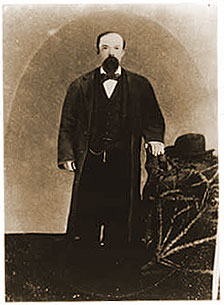 |
| Arguably the most famous character in American Whiskey today, Mr.Jack Daniels, has been dead for close to a century. When he died in 1911 after kicking a safe door and contracting gangrene, the business was successfully carried on by his nephew, Lem Motlow. |
Tennessee Whiskey
Tennessee whiskey is a first cousin of Bourbon, with virtually an identical history. The same sort of people used the same sort of grains and the same sort of production techniques to produce a style of whiskey that, remarkably, is noticeably different. The early whiskey distillers in Tennessee, for reasons that are lost in the mists of history, added a final step to their production process when they began filtering their whiskey through thick beds of sugar maple charcoal. This process, called the Lincoln County Process, removes some of the cogeners (flavour elements) in the spirit and infuses a sweet, smooth and sooty character into the distillate. Jack Daniel's & George Dickel, are the two remaining distillers in the state continuing this tradition, which a distiller at the Jack Daniel's Distillery once described as being"same church, different pew."
Tennessee Whiskey must contain a minimum of 51% corn (also called maize), be produced in Tennessee, be distilled at less than 80% Alc./Vol. (160 proof), filtered through a bed of sugar maple charcoal, and be aged for a minimum of two years in new charred barrels, but typically is aged for four or more years. The taste descriptors for Tennessee whiskey tend to parallel those of its Kentucky cousin. The distinction and the difference comes on the finish which is long, clean, and very, very smooth-a result of the final sugar maple charcoal filtration. Legally, Tennessee whiskeys could be sold as Bourbon; but the two Volunteer State distillers are proud enough of their "sipping whiskey" to insist that the difference be known to all. Ironically, Lynchburg, Tennessee where Jack Daniels is produced is a designated a dry area!
Other American Whiskey Styles
Blended American Whiskey
Blended whiskies date from the early 19th century when the invention of the column still made possible the production of neutral spirits. Distillers would blend one or more straight whiskies (Bourbon and Rye) with these neutral spirits in varying proportions to create their own brand. The taste and quality of these whiskies, then as now, varies according to the ratio of straight whiskey to neutral grain spirit. Modern blends utilize dozens of different straight whiskies to insure a consistent flavour profile and distillers have promoted them as a way of stretching their limited supply of straight whiskey. However. Blended whiskies became considered too bland by Bourbon and Rye lovers, and consumers with a taste for lighter spirits soon migrated to Vodka and Gin. Blended American Whiskey is required to contain at least 20% straight whiskey; with the balance being un-aged neutral spirit or, in a few cases, high-proof light whiskey. It has a general whiskey flavour profile (most closely resembling Bourbon), but lacks any defining taste
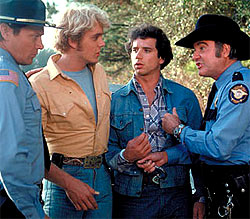 |
| Above: The 'good old boys', Bo and Luke Duke in the TV series, "The Dukes of Hazzard": Racing around in their modified '69 Dodge Charger, The General Lee (left), transporting moonshine and forever evading corrupt Boss Hogg and his inept county sheriff Rosco P. Coltrane. |
Moonshine
The name Moonshine Whiskey (a.k.a. white lightning, Corn likker, white dog, poitÃn, mooney, moon, creek water or hooch) is often assumed to be derived from the fact that moonshine producers and smugglers would often work at night (i.e. under the light of the moon) to avoid arrest for producing illegal liquor. It is distilled from a varied mix of corn and sugar and is aged in Mason jars and jugs rather than oak barrels and it often contains impurities, off flavors, and toxins such as methanol that the more sophisticated distillation methods are able to control. Moonshine is often portrayed in the media in a clay jug marked "XXX". Supposedly, the moonshiner would inscribe a single X on the jug each time the mixture passed through a still. This image of a jug or bottle marked XXX is still used in comic strips and cartoons to depict an intoxicating beverage. In popular culture, moonshine is usually presented as being extremely strong and in North America is commonly associated with the Southern United States, and Appalachia. In the 1980's television show (and 2005 movie) "The Dukes of Hazzard", moonshine was a central element of the plot. The Duke family were covert moonshiners, until the nephews were caught running moonshine out of the county. "Uncle Jesse" made a deal with the government to shut down the moon shining operation; in exchange, his nephews were released and were on probation for most of the series. Many of the early episodes center around moonshine made by someone else, usually associates of Boss Hogg, planting the said liquor on Duke property in an effort to revoke the younger Dukes' probation. This series plays off of a large number of the stereotypes commonly associated with the Appalachian moonshiners.
In popular culture, moonshine is usually presented as being extremely strong and in North America is commonly associated with the Southern United States, and Appalachia. In the 1980's television show (and 2005 movie) "The Dukes of Hazzard", moonshine was a central element of the plot. The Duke family were covert moonshiners, until the nephews were caught running moonshine out of the county. "Uncle Jesse" made a deal with the government to shut down the moon shining operation; in exchange, his nephews were released and were on probation for most of the series. Many of the early episodes center around moonshine made by someone else, usually associates of Boss Hogg, planting the said liquor on Duke property in an effort to revoke the younger Dukes' probation. This series plays off of a large number of the stereotypes commonly associated with the Appalachian moonshiners.
American Whiskey today.
It may seem odd, but Scotch whisky may be Bourbon's inspiration for long-term revival. The steady growth in sales of Scotch single malt and high-quality blended Scotch whiskies has not gone unnoticed in Bourbon country. All of the Kentucky and Tennessee whiskey distilleries are now marketing high-end "single cask" and "small batch" whiskies that have found great success among upscale consumers. The United States may yet, in the words of one commentator, "turn away from foreign potions and return to its native spirit."
 |
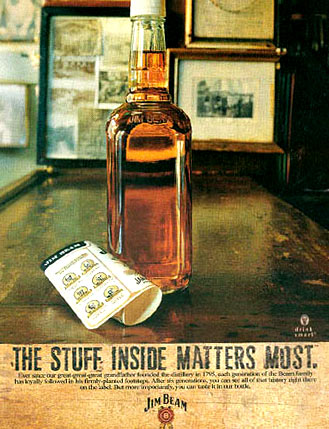 |
As competition from other spirits like Tequila and Vodka has increased, the Bourbon industry has also promoted its product in ever more daring and creative ways, more often than not directed towards a younger market. On the left, is an example from an Evan Williams campaign "The longer you wait, the better it gets." On the right, an effort from Jim Beam, "The Stuff Inside Matter Most".The concept of an advertisement that simply highlights the quality of a product is rare whereas the use of sexual symbols in modern advertising seems particularly prevalent within the alcohol industry. (Unfortunately, Jim Beam White Label is not an especially good Bourbon. The agency was over-selling the product in this case.)
More recently, an American micro distilling renaissance has been taking place. The inspiration behind much of this revival is fuelled by more than sheer entreprenuerial spirit. It harks back to an appreciation for things made by hand.
"...alcohol today, like most of what Americans consume, typically emerges from gigantic, antiseptic, computer-controlled megafactories." comments William Gurstelle, writing for "Popular Mechanics" magazine. "Limited-run, small-batch manufacturing, using carefully selected and often local ingredients, is gaining traction among consumers in search of authenticity and character. One manifestation of that trend is the craft distillery, a raw work space filled with alembics, coils, vats, and the smell of cereal and fermentation".
What's most impressive about this movement - aside from the frequently stunning quality - is the rapidity of growth. According to Bill Owens, founder of the American Distilling Institute, "Twenty years ago about 60 legal U.S. microdistilleries —those producing less than 65,000 gallons a year—existed; today [2012] there are 300-plus, with dozens more emerging each year"
Balcones and Koval are just two of the distilleries that have come to epitomise the American craft distilling movement.
A note on Canadian Whiskies...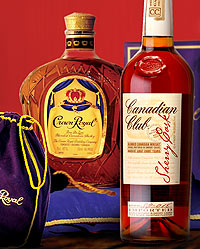
Canadian whiskies, as with their American counterparts, originated on small farms. English, Dutch and German immigrants bought tiny pot stills into the country. However, the core of the present industry really began in the big grist mills where the dominant grain, wheat, would be ground down to make flour. Excess wheat of inferior quality was used for whisky production, however the quality and flavour of the finished product was not particularly good and became known as "Common" Whisky. When a small amount of rye was included in the mash, it greatly improved the taste and so a Canadian 'style' of sorts was born.
A little rye goes a long way in a mash bill, and while most Canadian distillers also used corn, wheat, and other grains, Canadians referred to their whisky as "Rye", and still do. Today the mash bill for most Canadian Whisky is now predominantly a mix of corn, wheat, and barley, with only a modest proportion of rye for flavour. The result is a flavoursome but lighter-bodied spirit. There are no Canadian government requirements when it comes to the percentages of grains used in the mash bill.
Unlike Bourbons, they are aged, primarily in used oak barrels. The minimum age for Canadian Whisky is three years, with most brands being aged four to six years. Virtually all Canadian whiskys (except the pot-distilled malt whiskies of Glenora in Nova Scotia) are blended from different grain whiskies of different ages. Bulk Canadian Whiskys are usually shipped in barrels to their destination country where they are bottled. These bulk whiskies are usually bottled at 40% ABV (80 proof) and are usually no more than four years old. "Bottled in Canada" whiskies generally have older components in their blends and are bottled at 43.4% ABV (86.8 proof).
Famous examples of Canadian Whisky include Crown Royal & Canadian Club Blended Whisky.
The Mint Julep
Most likely originated in 1803, when John Davis, a traveler from Britain and a Virginia plantation tutor, defined a julep as "a dram of spiritous liquor that has mint in it, taken by Virginians of a morning". From there, it evolved into a putting mint and sugar into a tumbler, and then adding equal parts of peach and regular brandy. To this was added plenty of crushed ice. Traditionally, mint juleps were often served in silver or pewter cups, and held only by the bottom and top edges of the cup. This allows frost to form on the outside of the cup, which some would find a sign of gentility. Others merely find it pleasant to look at. It is well-known as the traditional beverage of the Kentucky Derby, a position it has held since 1938; during the event, more than 80,000 juleps are served at Churchill Downs.
Bob Dylan described in his Theme Time Radio Hour episode #3 how to make, by his preferences, a perfect mint julep: "First up, you take four mint sprigs, two and a half ounces of bourbon. I'd put three. A table spoon of powder sugar, and a table spoon of water. You put the mint leaves, powder sugar and water in a Collins glass. You fill the glass with shaved, or crushed ice, and then add bourbon. Top that off with more ice. And...I'd like to garnish that with a mint sprig. Serve it with a straw. Two or three of those, and anything sounds good."
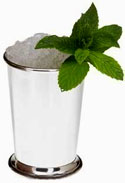
- 120ml Baker's Bourbon Whiskey
- 4-6 sprigs of mint
- 2 sugar cubes
- Method: Put Bourbon, Mint, and Sugar into the bottom of a cocktail shaker. Muddle to dissolve sugar and blend mint leaves. Let stand for a bit to help release the mint flavour. Add ice, and shake well to chill, then strain into a glass filled with shaved ice. Ahh, such a refreshing drink... (2)
The Manhattan
The Manhattan is a very old cocktail, most likely having been invented in the 1870's at New Yorks Manhattan Club from which it gets its name. It has the same sort of simplicity as a Martini, but with much more flavour. Originally, like most American Whiskey drinks prior to prohibition, this cocktail was made with Rye. Today, it is more commonly made with Bourbon, but only because there are a lot more Bourbon's on the market then there are Rye's. If you can find a good Rye, like Jim Beam's then by all means try it. The key to a good Manhattan is to create the right balance of all the flavours that go into it.
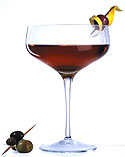
- 60ml Bourbon or Rye Whiskey
- 25ml Rosso Vermouth (sweet)
- 4 dashes Angostura Bitters
- Method: Pour the whiskey and Vermouth into a cocktail shaker. Add bitters, plenty of ice cubes and shake. Strain into Martini glass. Note: Canadian Whisky can be used as a substitute. (2)
The Old Fashioned
The first use of the specific name "Old Fashioned" was for a Bourbon whiskey cocktail in the 1880s, at the Pendennis Club, a gentlemen's club in Louisville, Kentucky. The recipe is said to have been invented by a bartender at that club, and popularized by a club member and bourbon distiller, Colonel James E. Pepper, who brought it to the Waldorf-Astoria Hotel bar in New York City. When properly made, this cocktail can represent the pinnacle of the bartenders trade. When done improperly, which is more often the case, it can be a disaster of mediocrity. One of the oldest recipes known going by the name of Old Fashioned, comes from "Modern American Drinks" by George J. Kappeler, published in 1895: "Dissolve a small lump of sugar with a little water in a whiskey-glass; add two dashes Angostura bitters, a small piece ice, a piece lemon-peel, one jigger whiskey. Mix with small bar-spoon and serve, leaving spoon in glass". This very closely resembles the recipe which you should be served by a modern day bartender.
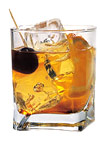
- 1/2 Orange Slice
- 1 cube of sugar
- 2 dashes of Angostura Bitters
- 60ml Rye or Bourbon whiskey
- Method: Muddle orange, sugar, bitters together until the sugar is mostly dissolved. Fill glass with ice, then add the whiskey. Garnish with a marachino cherry, and perhaps an additional orange slice. Serve with a swizzle stick and/or straw.(2)

1. Cowdery, Charles K., Bourbon, Straight: The Uncut and Unfiltered Story of American Whiskey, p. 25
2. Cocktail recipes & descriptions partly sourced from www.drinkboy.com
3. Some historical data sourced from www.tastings.com
4. The World Guide to Whisky, Michael Jackson, Golden Press 1987.
